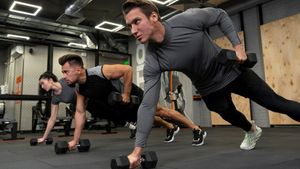YOGYAKARTA Katabolicism and anabolism constitute a series of body metabolic work to keep the body alive. Both help regulate molecules by releasing and capturing energy. How does catabolic and anabolic work? What are the differences between the two and their influence on weight? Check out the full explanation.
Anabolism centers on building and organizing molecules. In the process, small and simple molecules are transformed into complex massive molecules. An example of an anabolicism is a gluconegenesis that occurs when the liver and kidneys produce glucose from non-carbohydrate sources. Launching Healthline, Thursday, December 21, a catabolism is what happens when digesting food and molecule-molecules decompose in the body to be used as energy. Massive molecules complex inside the body, broken into simple small molecules in catabolicism. This process is called glycosis, the inverse of gluconegenesis.
Hormones play a major role in the process of catabolicism and anabolism. Anabolism involves hormone estrogen, insulin, growth hormone, and testosterone. While catabolic substances involve hormone adrenaline, cortisol, cytokines, and glucagon. Disorders in hormones, such as thyroid conditions, can affect the overall metabolic process.
Small research was conducted to examine the balance of catabolic-anabolicalism in bodybuilders. This study found that energy-constrained bodybuilding groups experienced a significant decrease in body fat and muscle mass compared to control groups. The testosterone levels also decreased between 11 and 5 weeks before the competition. In other words, the anabolic path' in men is disrupted even when they consume high proteins. From these studies, researchers concluded that binaries need to apply nutrient consumption strategies to prevent catabolic damage before competition.
Because catabolicism and anabolism are part of metabolism, this process affects weight. When you are in an anabolic state, you are building and maintaining muscle mass. When catabolic, fat and muscle are damaged or mass loss. That is, the catabolic and anabolic processes cause fat loss over time. However, it is important to pay attention to a number of notes.
Anabolic exercise tends to remove fat and retain or even add muscles. Muscles will be denser than fat so that body weight and body mass index may remain higher even though the body is slimmer. In contrast to catabolic exercises that can help lose weight and get rid of fat and muscle. Body weight will decrease, but muscle mass is also much less.
To lose weight while increasing muscle mass, you have to do catabolic and anabolic exercises in balance. If you produce more than you use, your weight may increase because the energy is stored as fat. If you use more than you produce, the opposite might happen.
Catabolic exercises include aerobics and cardio exercises, where the body is active for a relatively long period of time. According to the American College of Sports Medicine, try to do the number of aerobic exercises of 150 minutes of moderate intensity every week or 75 minutes of high intensity.
Anabolic exercise, to form muscles. This exercise should not take too long because it can reduce muscle mass and endanger overall health. Experts suggest that anabolic exercise to maintain muscles is carried out 3-4 days a week.
SEE ALSO:
In addition, focus on one area every week and rest for recovery on the day between them. This exercise includes bench press with dumbbell, crunch, deadlift, biceps exercise, abdominal, back, and triceps. Each exercise, do as many as 3 sets with 15 repetitions per set. Lower then to 12 and then 8 repetitions. You can also practice catabolic and anabolic in balance. For example with balanced strength and aerobic training and high intensity interval (HIIT) exercises.
The English, Chinese, Japanese, Arabic, and French versions are automatically generated by the AI. So there may still be inaccuracies in translating, please always see Indonesian as our main language. (system supported by DigitalSiber.id)


















